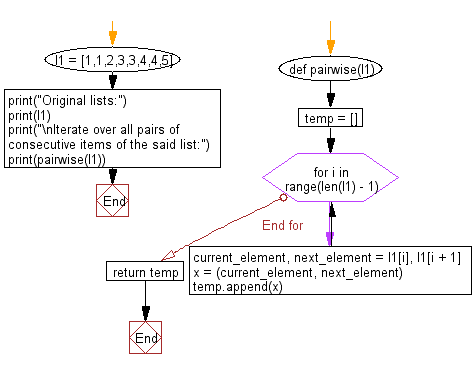Python: Iterate over all pairs of consecutive items in a given list
Python List: Exercise - 135 with Solution
Write a Python program to iterate over all pairs of consecutive items in a given list.
Sample Solution:
Python Code:
def pairwise(l1):
temp = []
for i in range(len(l1) - 1):
current_element, next_element = l1[i], l1[i + 1]
x = (current_element, next_element)
temp.append(x)
return temp
l1 = [1,1,2,3,3,4,4,5]
print("Original lists:")
print(l1)
print("\nIterate over all pairs of consecutive items of the said list:")
print(pairwise(l1))
Sample Output:
Original lists: [1, 1, 2, 3, 3, 4, 4, 5] Iterate over all pairs of consecutive items of the said list: [(1, 1), (1, 2), (2, 3), (3, 3), (3, 4), (4, 4), (4, 5)]
Flowchart:

Visualize Python code execution:
The following tool visualize what the computer is doing step-by-step as it executes the said program:
Python Code Editor:
Have another way to solve this solution? Contribute your code (and comments) through Disqus.
Previous: Write a Python program to find the difference between two list including duplicate elements.
Next: Write a Python program to remove duplicate words from a given list of strings.
What is the difficulty level of this exercise?
Test your Programming skills with w3resource's quiz.
Python: Tips of the Day
Find current directory and file's directory:
To get the full path to the directory a Python file is contained in, write this in that file:
import os dir_path = os.path.dirname(os.path.realpath(__file__))
(Note that the incantation above won't work if you've already used os.chdir() to change your current working directory, since the value of the __file__ constant is relative to the current working directory and is not changed by an os.chdir() call.)
To get the current working directory use
import os cwd = os.getcwd()
Documentation references for the modules, constants and functions used above:
- The os and os.path modules.
- The __file__ constant
- os.path.realpath(path) (returns "the canonical path of the specified filename, eliminating any symbolic links encountered in the path")
- os.path.dirname(path) (returns "the directory name of pathname path")
- os.getcwd() (returns "a string representing the current working directory")
- os.chdir(path) ("change the current working directory to path")
Ref: https://bit.ly/3fy0R6m
- New Content published on w3resource:
- HTML-CSS Practical: Exercises, Practice, Solution
- Java Regular Expression: Exercises, Practice, Solution
- Scala Programming Exercises, Practice, Solution
- Python Itertools exercises
- Python Numpy exercises
- Python GeoPy Package exercises
- Python Pandas exercises
- Python nltk exercises
- Python BeautifulSoup exercises
- Form Template
- Composer - PHP Package Manager
- PHPUnit - PHP Testing
- Laravel - PHP Framework
- Angular - JavaScript Framework
- Vue - JavaScript Framework
- Jest - JavaScript Testing Framework
